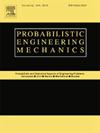优化调谐质量阻尼-干涉系统以提高结构抗震性能的可靠性设计表
IF 3
3区 工程技术
Q2 ENGINEERING, MECHANICAL
引用次数: 0
摘要
调谐质量阻尼器(TMDI)作为一种很有前途的结构减震装置,近年来受到了广泛的关注。然而,现有的TMDI设计方法,如基于不动点理论的公式和随机优化方法,往往存在控制增益不足或计算量过大的问题。为了解决这些问题,本研究开发了一种基于可靠性的多参数设计表(MPDT),以快速、准确和非迭代的方式优化TMDI。MPDT采用基于重复可靠性的设计优化(RBDO)方法,将概率密度演化法(PDEM)与遗传算法相结合。它确保了TMDI在随机地面运动下的稳健性能,并有助于在不同结构周期和地震条件下有效选择关键参数,包括质量比、质量比、阻尼比和频率比。此外,它还为合理选择TMDI拓扑(如TMD、TID或全TMDI)提供了指导。通过对基础隔离结构和具有不同TMDI配置的五层剪力框架结构的案例研究,验证了MPDT的有效性。结果表明,基于mpdt的TMDI设计实现了与全RBDO设计相当的控制性能,同时显著减少了计算量。研究了结构模态频率、互连器连接和TMDI放置等关键影响因素,揭示了即使部分满足设计假设,所提出方法的鲁棒性。此外,还揭示了设计趋势,如惯性与结构周期之间的关系。总的来说,MPDT为基于性能的TMDI系统抗震设计提供了一个可靠、高效、可扩展的框架,支持实际工程应用。本文章由计算机程序翻译,如有差异,请以英文原文为准。
Reliability-informed design table for optimizing tuned mass-damper-inerter systems to improve structural seismic performance
As a promising device for seismic mitigation of structures, the tuned mass-damper-inerter (TMDI) has attracted considerable attention in recent years. However, existing design methods of TMDI such as the fixed-point theory-based formulas and stochastic optimization methods, often suffer from insufficient control gains or excessive computational demands. To address these issues, this study develops a reliability-informed multi-parameter design table (MPDT) for optimizing TMDI in a fast, accurate, and non-iterative manner. The MPDT is developed through repeated reliability-based design optimization (RBDO), integrating the probability density evolution method (PDEM) with genetic algorithms. It ensures robust TMDI performance under stochastic ground motions and facilitates efficient selection of key parameters, including mass ratio, inertance-to-mass ratio, damping ratio, and frequency ratio, across varying structural periods and seismic conditions. Additionally, it provides guidance for rational selection of TMDI topology, such as TMD, TID, or full TMDI. The MPDT is validated via case studies on a base-isolated structure and a five-story shear frame structure with various TMDI configurations. The results demonstrate that the MPDT-based TMDI designs achieve comparable control performance to full RBDO designs while significantly reducing computational effort. Key influences such as structural modal frequency, inerter connection, and TMDI placement are examined, revealing the robustness of the proposed method even if the design assumptions are partially fulfilled. Furthermore, design trends, such as the relationship between inertance and structural period are uncovered. Overall, the MPDT provides a reliable, efficient, and scalable framework for performance-based seismic design of TMDI systems, supporting practical engineering applications.
求助全文
通过发布文献求助,成功后即可免费获取论文全文。
去求助
来源期刊

Probabilistic Engineering Mechanics
工程技术-工程:机械
CiteScore
3.80
自引率
15.40%
发文量
98
审稿时长
13.5 months
期刊介绍:
This journal provides a forum for scholarly work dealing primarily with probabilistic and statistical approaches to contemporary solid/structural and fluid mechanics problems encountered in diverse technical disciplines such as aerospace, civil, marine, mechanical, and nuclear engineering. The journal aims to maintain a healthy balance between general solution techniques and problem-specific results, encouraging a fruitful exchange of ideas among disparate engineering specialities.
 求助内容:
求助内容: 应助结果提醒方式:
应助结果提醒方式:


